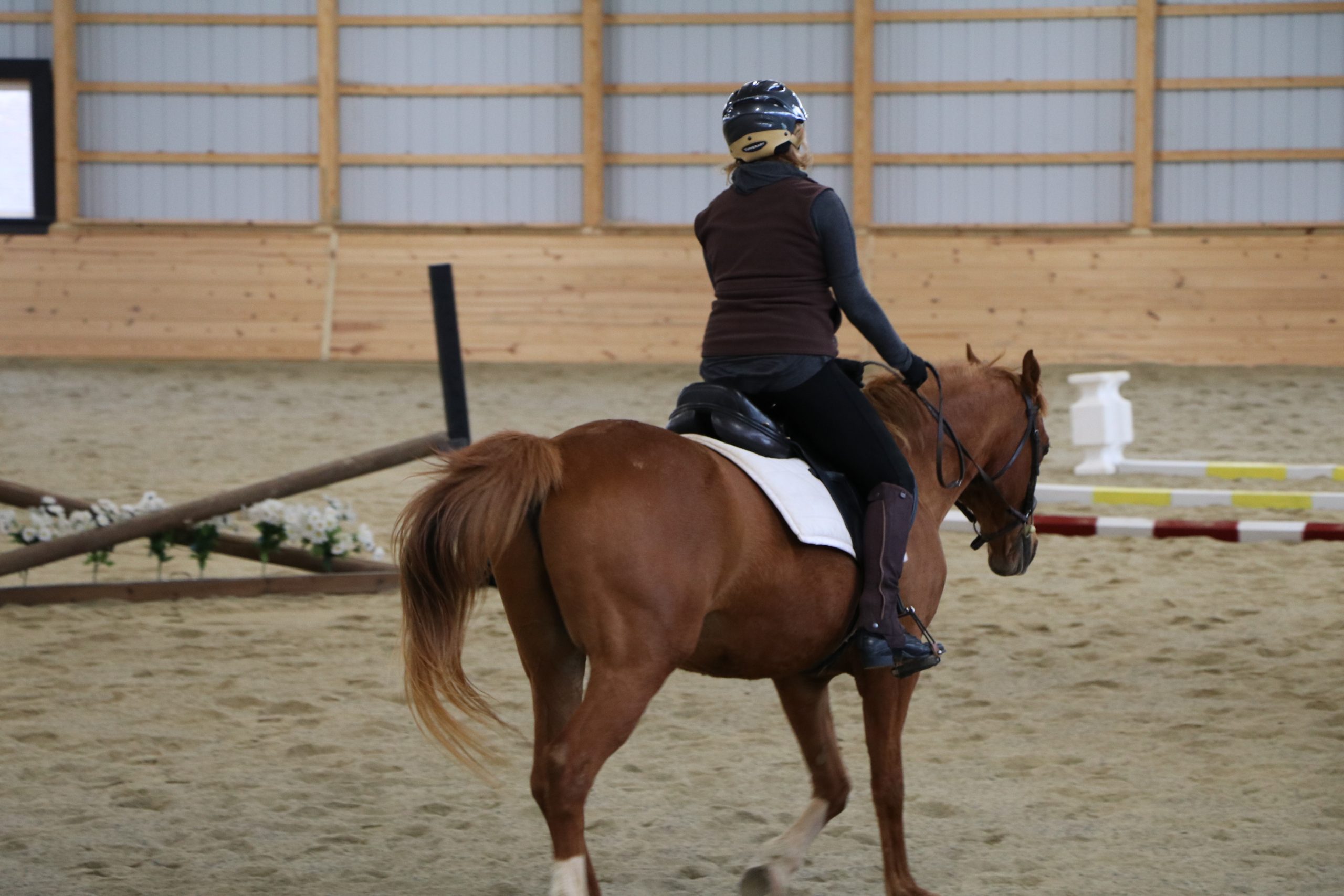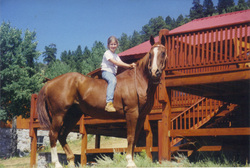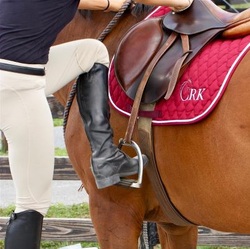What part of our riding “position” is constant, regardless of the tack we’re using or what we are doing with our horse, and what changes?
The idea for this video came from a remark one of my students made during a recent riding lesson. She said, “I can’t wait to figure out my position so I can move on and learn other things.”
Her comment made me think about how while there are keys to great riding position that don’t change, the more skilled and experienced we become as riders, the more dynamic and adjustable our position becomes…
I explain more in today’s video, hit play below.














30 Responses
For me when riding any horse, especially out on trails, one of the key things is to be centered- and to align with his center of balance; then if he makes a sudden move I can stay with him
Thank you so much for sharing your knowledge!
As a “re-horse woman” (had horses as a teen and have recently bought a horse at age 59) I am much more interested in the dynamics of riding than I was as a teen. I’m more cautious, and concerned with how my horse is feeling. I previously rode hunter seat/English but am slowly morphing into a more relaxed Western style. I just bought a Tucker Endurance saddle and feel much more secure in it. I also bought a HitAir vest because I am timid now and afraid of falling!
I am always searching for my seat & trying to be aware of rein pressure, so I find your information so helpful! Thanks again.
I ride english on the flat with my Arabian, Allie. The most amazing awareness that I learned several years ago was the contact of my seat bones into the saddles and how I use them helps me to communicate with my horse. I tend to lean forward in my saddle when I get tense and have to remind myself to keep contact and sit back and relax. Your video helped my thinking in balance. I am 60 years old and getting back into the saddle once again.
I believe that learning to ride with an efficient, dynamic seat is a spiral process. One learns the basics at a walk and is perhaps able to begin to add in some dynamics like following hands. Then at the trot, we need to learn how to maintain what we learned at the walk with the added challenge of the horses’s changed movement pattern. The spiral comes around again and we are challenged by maintaining that dynamic seat at a canter. I have been riding a long time and this something I still need to work on!
What has made a huge difference for me….just moving my knees slightly forward and down for each stride of my horse helped with her forward movement!
Hi Callie, thanks for a very thought-provoking video. A new riding student has a lot to think about. “Lower your heels, close your fingers, look where you’re going, breathe, shoulders back, eyes up, sit up, change your diagonal, shorten your reins …”. It seems like every part of your body is used in riding and needs your attention. Meanwhile, students are often just trying to keep that lesson horse going straight, maintain the pace, and not fall off. Add in the fact that a new student generally lacks the muscle strength and often, the general fitness level needed to do these things, and may only ride once or twice a week, and you have some real challenges for both the student and the instructor. Perhaps, like other athletes, riders would benefit from a well-designed workout program that strengthened those areas of our body that we need to ride well.
You have nailed it!
Callie’s next online course! I would take it.
There’s a fantastic online rider fitness program called Dressage Rider Program. Applies to all riders, not just dressage and I cannot say enough about how good the program is!!!
It has been slow going but I feel I am getting better at achieving a secure and stable seat, sitting up straight keeping a good line from head to heel, giving with my hands and hips with the horse’s movement, keeping weight in my heels, etc., but there must still be something I am doing wrong. I continue to have trouble with keeping my feet securely in the stirrups at the canter. I can ride the canter with a deep seat or half seat if I can get past asking for the canter. When I ask for the canter, apply pressure, or nudge with my heels, I lose good position in the stirrups. When I do any of these things, the stirrup may drop off or my foot or slide back on my foot until it is under the arch of my boot rather than on the balls of my feet. I am constantly adjusting my feet in the stirrups! What am I doing wrong?
Sounds like you need to think weight in your heels and relaxed ankles
Wait for the horse, apply the aids, keep your shoulders back (a little.. dont lean backwards) and let the horse go. If you are putting your outside leg back, think of moving your leg backward (not too far!) from the hip socket. You might be moving only from the knee.
I now ride primarily Western and I love doing Working Equitation.
The one thing that I find makes a big difference for me is my butt! (Pardon my language.) I’ve learned that the days my riding or my position just feel “off” I am clenching with my butt cheeks! This has a domino effect and I can very quickly find myself stiff through my entire body. So when I find that I just seem stiff or off balance the first thing I do is make a conscious effort to just sit softly. I lately have ridden a lot in a bareback pad which makes this a bigger challenge! But I find that in conquering the challenge bareback, I have less times I need to actively correct this problem in the saddle.
(I hope this makes sense.)
I’ve been fortunate to be able to ride a number of disciplines. The majority of my riding has been divided between Hunter Jumper and competing on Cutting Horses. I’ve also taken dressage lessons and for a little while even played some Polo. I’m not telling you this because I’m some great rider. I’m not. My riding experience has taught me something about my own riding position. And for what it’s worth, I thought I’d share a realization I had that really helped me.
Each of the disciplines I’ve ridden required something a little different, an adjustment in position so I could be in sync with my horse. In each of these disciplines, it felt like the horse had a different “balance point”. A point that I needed to find with my body so the horse and I could work together.
I agree totally with Callie that “part of our riding position is constant regardless of what tack we’re using or doing with our horse”. But the problem I had when I first started riding was trying to “hold” a certain position. All the things I was told to do with my body (“Heels Down”, “Shoulders Back”, “Elbows”, “Flat Back”, Head Up”) made me rigid and tense. I was trying to force my body to stay in the “perfect riding position”. I can tell you riding that way wasn’t appreciated by those selfless school horses that were trying help me learn to ride.
And then one day, something magical happened. I think I was just plain tired and I “relaxed into position”. That was a special moment for me (and my horse). My weight settled where it should be and I could feel my horse under me. Jumping courses became easier. And when I started Cutting, being relaxed, and working with the horses center of balance, made that an easier learning experience and more fun for both me and the horse.
Just to show you I’m not some natural horseman, when I started taking Dressage lessons, for the first half of the lesson I forgot what I had learned about relaxing. I’m sure the horse thought he was being ridden by a post. I couldn’t have been less dynamic. When it finally dawned on me to relax into position, things immediately got better. I know the horse was probably thinking, thank goodness, now I can relax too.
If I have any advice for new riders it would be, learn to relax in your riding position. I know it’s hard. You’re being asked to use your body in new ways. But when you finally “relax into position” you will find that both you and your horse will benefit.
There’s no doubt you need a “Dynamic Riding Position”. I just think you have a better chance of finding it if you “Find Your Relaxed Riding Position” first.
Callie, You do a great job. I enjoy your videos. Thanks, and keep the learning coming.
Greg
I first learned to ride in an English saddle and competed in many different classes. Riding western came years later. I now ride using an Endurance saddle. For me, having a good seat is the foundation for riding. As you stated, higher levels skills are built upon this foundation.
Before riding in a saddle, I had to first learn to ride bareback at the walk, trot and canter. I quickly learned that being free of tension and having soft joints, allowed me to move more easily with the horse. So, your comments about soft joints and being free of tension brought back memories for me. I liken tension and bracing to a stick on a bouncing ball: because it is SO stiff, it quickly comes (falls) off. Riders that brace tend to come off easily or quickly become off balanced and find other means for staying on. Whereas, a wet rag that is “relaxed” on a bouncing ball, tends to stay on and moves with the ball. A relaxed rider -free of tension and with soft joints- rides with greater ease on a moving horse. I then learned how to ride in a saddle versus using a saddle to stay on. Learning soft hands and soft elbows came next. Though many would disagree, I agree completely that the basic principals apply to all disciplines.
Ten years ago when I bought my QH mare, the previous owner kept reminding of the horn and to “use it” if needed. I was confused and finally asked her why. She explained it was to help me stay on! I was even more confused. I laugh about it now and maybe that is why I eventually chose to ride in a hornless endurance saddle. Since I was involved in endurance riding, I chose the hornless option. I didn’t have a need for a horn. Thank you for sharing your videos and encouraging discussion as both provide insight and learning opportunities.
I like your explanation of the difference between principles and position, and how mastering the principles will help in applying the necessary flexibility to position.
As a new rider, I was at the point that I honestly thought I would NEVER find my balance. Despite my best efforts to keep tall and look ahead – followed my instructors comments exactly – I became despondent that improvements were not happening. Today, however, I had a real moment of annoyance with my horse and I realised it was because we were not in sink at all! She wanted to make little effort while I was heel tapping forwards and trying to stay in balance… ‘Use a short whip!’ my instructor called, and out of desperation I did. I had hesitated to do this before because I was worried I would be too hard, etc., Not at all! It worked – horse moved beautifully and consistently and I felt like I was really riding. I could actually feel my balance, beame calmer, taller, and must put it down to better command and control of the horse with this little tool. Sometimes it takes a long time to learn a small thing…
I ride both English and Western and at 61 I find that my balance is harder to achive now then when I was younger. I find doing a bit of Yoga first opens up my hips and stretches me out and focus on my horse and myself as a single unit has helped tremendously! Thanks Callie
My most “ride changing” epiphany was learning how to open my hips. I’ve read about it, heard about it, but until I actually felt when I successfully did, I had no idea. Like Karen wrote “just moving my knees slightly forward and down for each stride of my horse” is huge. I feel myself getting tense, therefore stiff, and consciously do this and immediately feel the difference in my horse. Also, learning that when I cue with whatever part of my body, do so as lightly as possible. If I put weight in a stirrup or seat bone, that doesn’t mean half my body weight – just the slightest shift and my horse feels it. Whisper, don’t scream.
Your comment in an earlier session that the knee movement is almost like kneeling has been an epiphany for me. Walk, trot, and canter are so much easier now, for me and my horse. When I find Macs tensing, I know that I am, too, so remember to breathe out (I tend to forget that) and kneel. Immediately, my body relaxes and Macs does,too. That one comment has helped me do more to relax in my seat than anything else I have learned.
Hi love these video they are so helpful. I am a mature beginner and I am really struggling with my foot position. I get it right in one lesson the next it falls forward. Any advice would be appreciated.
Hi Nicky,
You may be trying to improve too many things at once… learning often happens best when we can focus on just one new movement or piece of information at a time, when that improves and starts to become automatic, then we move on to the next piece.
Nicky, I’m a mature beginner, and my ankles are not so flexible as younger riders; when you can’t keep your heels down, your foot slips a lot easier. I’ve started a habit of every time I go up a flight of stairs, if at all possible, I stop once or twice on the way up for a 15-20 second calf stretch – stand on the edge of a step on the ball of my feet and drop my heels down for a good stretch (don’t bounce, just let the stretch happen). Doing this regularly is really helping ‘heels down’ become more natural, and increasing ankle flexibility, which in turn helps my feet stay where they belong.
A mature intermediate rider with a horse who isn’t easy but a smooth wonderful ride when she finally goes. Because Maggi stops and starts, I found keeping my position difficult. Once a learned to ride on my thigh and keep my feet off of her if she was listening, I felt more stable. It is hard to return to that feeling of being secure when regular riding has been interrupted by lameness or my own busy schedule. How can I get it back quickly?
Being able to ride a horse is quite an achievement worth celebrating. There is no exaggeration on this, and that is what comes to mind whenever I remember the day I was able to ride one. The joy of such special experience and the excitement to learn is truly worth keeping. With your post I am excited to also learn those dynamic riding positions. Awesome video by the way! ☺
I’ve found an “open” hip and breathing into my lower back to avoid arching has helped me feel more centered and my horse more relaxed. I practice lengthening my leg and opening my hips by dropping the stirrups and letting my legs hang at the beginning and the end of the ride, or anytime I start to tense up. When I put my feet back into the stirrups I can feel a big difference. I ride for pleasure, mostly on the trails in English or Western tack. I ride alone and keep my horse at home, away from the barn scene you really have to be reflective and notice your own body, no one else (except your horse) will tell you if your leg is too far forward or you’re gripping with your hands. If it is safe for you, consider riding out alone occasionally. Thanks for the video!
I agree that dropping one’s stirrups really helps with opening the hips and also with feeling the “sit bones”. If it is safe, briefly closing one’s eyes also makes one more aware of the movement of the horse and how it affects one’s body. I have only been brave enough to do it at a walk, but I imagine doing it at other gaits (maybe on a lunge line) would also help to feel the movement of the horse. I do often keep reminding myself to find the feeling of kneeling in the saddle. At first this suggestion confused me. I kept thinking of kneeling on the floor and envisioned pressure on the front of the knee–not a useful image for riding. I then realized the importance of kneeling in the saddle was the feeling of opening the hip–what the angle of the hip would be in kneeling vs. sitting. My early riding career consisted of hearing “heels down” an untold number of times. When I came back to riding recently after decades off the horse, I could indeed keep my heels down, but this tended to swing my leg forward. Now I try to use the image of kneeling in the saddle along with keeping my weight on the stirrup iron, rather than forcing my heels down. Walk and trot are coming along well. Like Cathy above, I sometimes have difficulty keeping my weight in my stirrups when I sit the canter, although two-point at a canter isn’t a problem.
Hi, I am a mature beginner and have seen several comments about ‘kneeling’ in terms of position. Do you have any further information I can go to, to better understand this concept please?
Many thanks.
Hayley
For me it was when I realised that everything is connected ie I tend to bend forward and down,many years of hairdressing must have exasperated this,so I’ve done this until it’s become second nature on my horse and off ,first align my head, then Shoulders,arms rib cage and back,relax the hips and the legs fall naturally round the horse,all to be done softly following the horses movement .sounds perfect,well im still working on it ! I read that it takes a thousand reps to change a muscle memory,I think it’s more! But I want to be the best I can be for my horse and for me ,I often practice when out hacking on the buckle end .Thanks Callie your work is so valuable to the rider and the benefit of our horses.
One of the first video’s I saw from you was how to keep heels down. I was said in the lesson to lower deeply my heels. It made me stiff and unstable. When I followed your advice not to force my heels down made a big difference. The same instead of “turn the toes inside” ” turn the heels out” solved not only the problem of the toes but more. It seems a small difference but it is really big difference.
Lately I struggle with a problem namely when trainers give instruction ( for example to stop) without saying how/what to do while I ‘m trying to perform it as I learnt but without succes. Only giving the same instruction repeatedly makes me uncertain only (about my way of riding) and I wish I knew what to do next. I ride school horses.